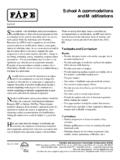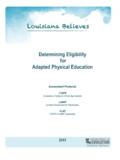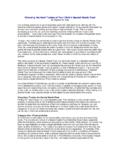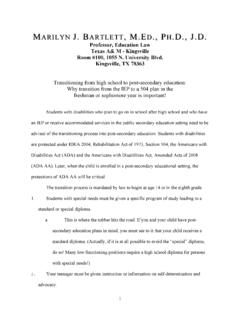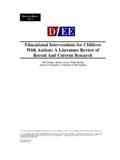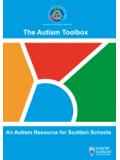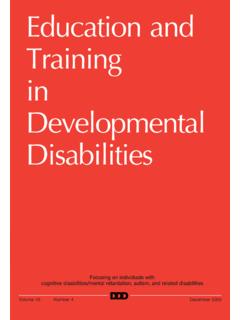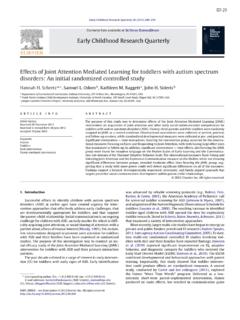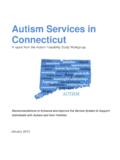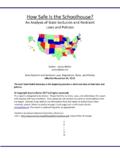Transcription of Current Interventions in Autism — A Brief Analysis
1 Autism Society of America Page 1 of 2 Autism TreatmentsCurrent Interventions in Autism A Brief AnalysisLovaasTEACCHPECS Background Goals How Implemented Reported Outcomes Advantages of Approach Concerns with Approach Errors to Avoidalso known as Discrete Trial (DT), IntensiveBehavior Intervention (IBI), AppliedBehavior Analysis (ABA); DT was earliestform of behavior modification; initialresearch reported in 1987; initial intent toachieve inclusive kindergarten readiness;has morphed into IBI and child how to learn by focusing ondeveloping skills in attending, imitation,receptive/expressive language, pre-academics, and ABC model; every trial or task given tothe child consists of: antecedent adirective or request for child to perform anaction, behavior a response from thechild that may include successfulperformance, non-compliance, no response,consequence a reaction from thetherapist, including a range of responsesfrom strong positive reinforcement to faintpraise to a negative No!
2 , pause toseparate trials from one another (intertrialinterval).first replications of initial research reportinggains in IQ, language comprehension andexpression, adaptive and social need for 1:1 instruction; utilizesrepetitions of learned responses until firmlyimbedded; tends to keep child engaged forincreasing periods of time; effective ateliciting verbal production in selectchildren; is a jump start for manychildren, with best outcomes for those inmild-to-moderate promoted as THE approach forautism in absence of any comparativeresearch to support claim; no differentiationfor subtypes when creating curriculum;emphasizes compliance training, promptdependence; heavy focus on behavioralapproach may ignore underlying neurologi-cal aspects of Autism , including issues ofexecutive function and attention switching;may overstress child and/or family.
3 Costsreported as high as $50,000 per child peryear; prohibits equal dependency on 1:1; overstressingchild or family; interpreting all behaviors aswillful rather than neurological manifesta-tions of syndrome; ignoring sensory issuesor processing difficulties; failing torecognize when it is time to move toanother for Treatment and Education ofAutistic and related Communication-handicapped Children; over 32 yearsempirical data on efficacy of TEACCH approach exists; includes parents as co-therapists; recognizes need for supportsfrom early childhood through adulthood;main focus is on Autism rather strategies that support personthroughout lifespan; facilitate autonomy atall levels of functioning; can be accommo-dated to individual organized, structured, modifiedenvironments and activities; emphasis onvisual learning modalities; uses functionalcontexts for teaching concepts; curriculum isindividualized based on individualassessment; uses structure and predictabilityto promote spontaneous in function and development;improved adaptation and increase infunctional skills; learned skills generalizedto other environments; North Carolinareports lowest parental stress rates and rateof requests for out-of-home placement, andhighest successful employment model that takes advantage ofand incorporates research from multiplefields; model does not remain static;anticipates and supports inclusivestrategies; compatible with PECS, FloorTime, OT, PT, selected therapies; addressessub-types of Autism , using individualizedassessment and approach.
4 Identifiesemerging skills, with highest probability ofsuccess; modifiable to reduce stress on childand/or that TEACCH gives in to autismrather than fighting it; seen by some as anexclusionary approach that segregateschildren with Autism ; does not placeenough emphasis on communication andsocial development; independent workcenters may isolate when there is a need tobe with other children to develop to offer sufficient training,consultancy, and follow-up training toteachers for program to be properlyimplemented; treating TEACCH as a singleclassroom approach rather than acomprehensive continuum of supports andstrategies; expecting minimally trainedteacher to inform and train all otherpersonnel in TEACCH approach; failingwork collaboratively with for Picture Exchange CommunicationSystem; derived from need to differentiatebetween talking and communicating;combines in-depth knowledge of speechtherapy with understanding of communica-tion where student does not typically attachmeaning to words and lack of understand-ing of communication exists; highcompatibility with child spontaneously initiate communi-cative interaction; help child understandthe function of communication; developcommunicative that young children with autismare not strongly influenced by socialrewards; training begins with functionalacts that bring child into contact withrewards; begins with physically assistedexchanges and proceeds through ahierarchy of eight phases.
5 Requires initialratio of 2 Educational Consultants reportincoming empirical data supporting:increased communicative competencyamong users (children understanding thefunction of communication); increasingreports of emerging spontaneous to get language started; addressesboth the communicative and social deficitsof Autism ; well-suited for pre-verbal andnon-verbal children AND children with ahigher Performance IQ than Verbal IQ;semantics of PECS more like spokenlanguage than suppress spoken language (evidence isto the contrary).failing to strictly adhere to the teachingprincipals in Phase I; tendency to rushthrough Phase I or to use only one trainer;providing inadequate support or follow-upfor teacher after attending two-daytraining; training only one person inapproach rather than all classroompersonnel; inconsistently implementing inclassroom.
6 Autism Society of America Page 2 of 2 Autism TreatmentsCurrent Interventions in Autism A Brief AnalysisGreenspanInclusionSocial Stories Background Goals How Implemented Reported Outcomes Advantages of Approach Concerns with Approach Errors to Avoidalso known as Floor Time, DIR (Developmen-tal Individual-Difference, Relationship-Based)Model; targets emotional development followingdevelopmental model; depends on informedand acute observations of child to determinecurrent level of functioning; has child-centeredfocus; builds from the child; Floor Time is onlyone piece of a three-part model that also includesspontaneity along with semi-structured play, andmotor and sensory personal interactions to facilitatemastery of developmental skills; helpsprofessionals see child as functionallyintegrated and connected; does not treat inseparate pieces for speech development,motor development, in interactive contexts; addressesdevelopmental delays in sensory modulation,motor planning and sequencing, and perceptualprocessing; usually done in 20-minutesegments followed by 20-minute breaks,each segment addressing one each ofabove-identified parents how to engage child inhappier, more relaxed ways.
7 Hypotheticallylays stronger framework for futureneurological/cognitive emotional development incontrast to other approaches, which tend tofocus on cognitive development; avoidsdrilling in deficit areas, which feeds child sfrustrations and highlights inadequacies; isa non-threatening approach; helps to turnchild s actions into not focus on specific areas forcompetency; no research to support efficacyfor children with Autism ; approach basedon hypotheses, not research; is a morepassive to implement approach withouttraining or professional oversight; takingthe lead, trying to get the child to do whatYOU think he should do; allowinginadequate time; attempting to implementin midst of ongoing activities for known as Social Scripts; developed byCarol Gray in 1991 initially to help studentwith Autism understand rules of a game;was further developed to address under-standing subtle social rules of neurotypical culture; addresses Theoryof Mind deficits (the ability to take theperspective of another person).
8 Clarify social expectations for students withASD; address issues from the student sperspective; redefine social misinterpreta-tions; provide a guide for conduct or self-management in specific social or scripts are specific to the person,addressing situations which are problematicfor that individual; Social Stories typicallycomprised of three types of sentences:perspective, descriptive, and directive; typesof sentences follow a ratio for frequency ofinclusion in the Social Story; Social Story canbe read TO or BY the person with Autism ;introduced far enough in advance ofsituation to allow multiple readings, butespecially just before the situation is to of behavior specific to thesituation being addressed; reduction infrustration and anxiety of students;improved behavior when approach isconsistently specifically to address autisticsocial deficits; tailored to individual andspecific needs; is time and cost data is anecdotal rather thanempirical; benefit depends on skill of writerand writer s understanding of Autism , aswell as writer s ability to take an too many directive sentences inproportion to perspective and descriptivesentences; stating directive sentences ininflexible terms ( , I will do __ ratherthan I will try to __ ); writing above theperson s cognitive developmental age; usingcomplex language; not being specificenough in describing either the situation orthe desired behavioral intended for children with mentalretardation and disabilities other thanautism.
9 Sociological, educational, andpolitical mandates in contrast to psychol-ogy as root source for other approaches;inclusion defined in three federal laws PL 94-142, REI, and IDEA educate children with disabilities with NTchildren to the maximum extent possible;educate children with disabilities in thechronological setting they would be in if theyhad no disability and they lived at home;does not apply separate educational channelsexcept under specific with Autism typically placed ininclusive settings with 1:1 aide; curriculummodified to accommodate to specificlearning strengths and deficits; requiresteam approach to planning; approach maybe selective inclusion (by subject matter orclass), partial inclusion (1/2 day included,1/2 day separate instruction), or full, radicalinclusion with no certain circumstances, some children withautism can survive and even become moresocial in classrooms with NT peers; benefitschildren who cognitively match opportunities for role modeling andsocial interaction; greater exposure toverbal communication; opportunities forpeers to gain greater understanding of andtolerance for differences; greater opportuni-ties for friendships with typicallydeveloping inclusion violates spirit and letterof IDEA; opportunities for successfulinclusion begin to plateau by end of thirdgrade as work becomes more abstract andfaster paced.
10 Increasing use of language-based instruction puts students with autismat great disadvantage; sensory andprocessing difficulties tend to be insuffi-ciently accommodated; regular educationsetting not necessarily best learningenvironment for students with Autism ;teachers and students in inclusionclassrooms are typically ill prepared toreceive insufficient training, preparation,information, and support to personnel;placing student in settings where level ofauditory and visual stimulation is typicallytoo intense; assigning student work inwhich cognitive demands exceed student sability to comprehend; depending onsupport of 1:1 aide; maintaining placementin face of frequent or severe disruptivebehaviors; focusing on academics todetriment or exclusion of functionalcompetencies; not offering multipleopportunities to apply functional skills.
